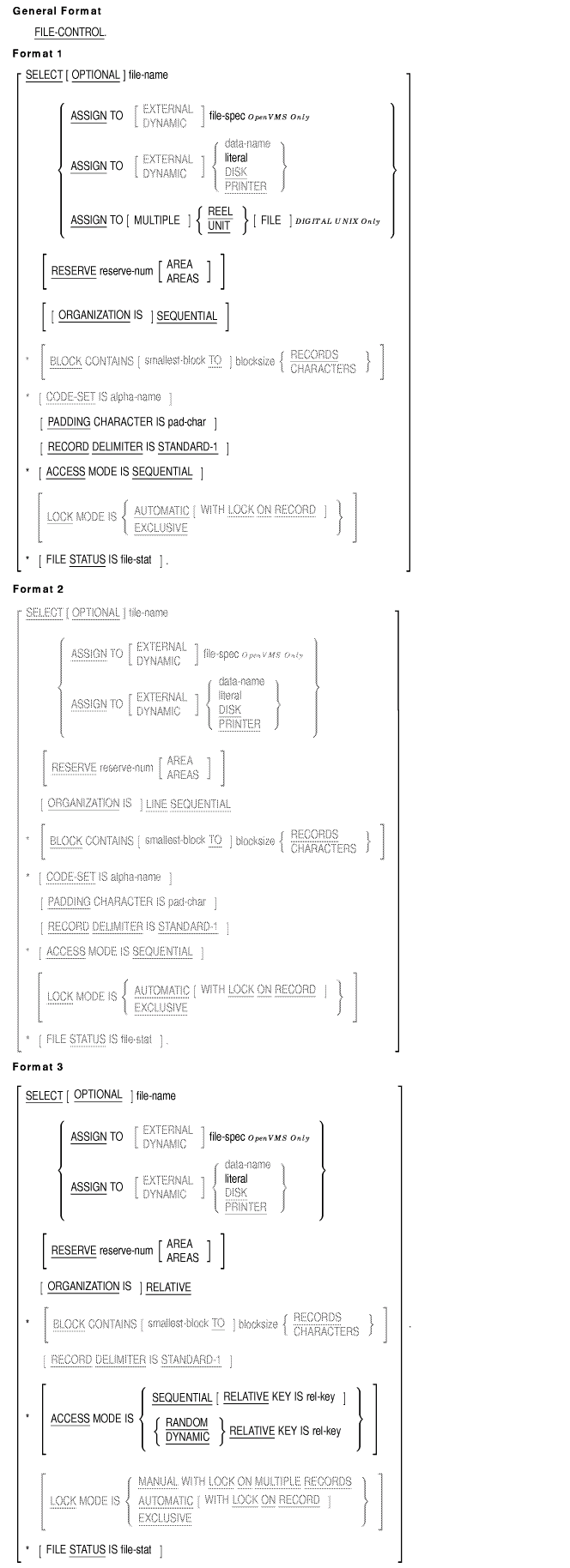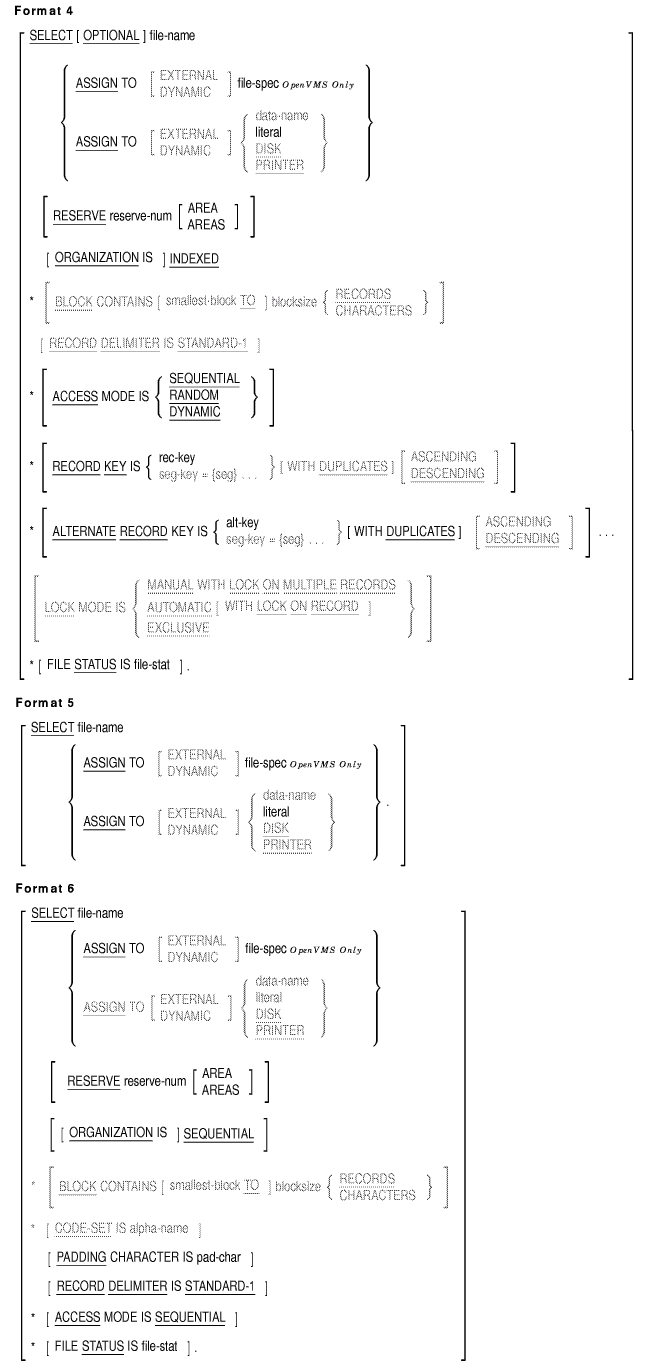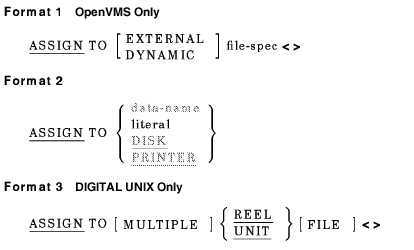Compaq COBOL
Reference Manual
DECIMAL-POINT IS COMMA Clause
- The DECIMAL-POINT IS COMMA clause exchanges the functions of the
comma and period in: (1) the PICTURE clause character-string and (2)
numeric literals.
CURSOR IS Clause (Alpha)
- The CURSOR IS clause specifies the initial position of the cursor
at the start of an ACCEPT (Format 5) statement. If
cursor-position is within an input or update field on the
screen, then the initial cursor position is at the start of that field.
If the CURSOR IS clause is not specified, or if
cursor-position is not within an input or update field on the
screen, the cursor's initial position is at the start of the first
input or update field of the screen. The cursor-position is
updated upon completion of the ACCEPT statement to contain the position
of the cursor when the ACCEPT terminated.
- In the CURSOR IS clause, if cursor-position is four
characters in length, the first two characters represent the line
number, and the second two the column number. If
cursor-position is six characters in length, the first three
characters represent the line number, and the second three the column
number.
CRT STATUS IS Clause (Alpha)
- If the CRT STATUS IS clause is specified, crt-status-code
is updated after every ACCEPT (Format 5) statement. The first two
characters are a termination code that indicates the cause of the
termination of the ACCEPT operation. (The third character is currently
not defined, and is reserved for future use.) The termination codes are
explained in Table 4-1.
Command Line Arguments (Alpha)
- The ARGUMENT-NUMBER and ARGUMENT-VALUE clauses are used to process
command line arguments. The DISPLAY statement is used to select and
modify the values, and the ACCEPT statement is used to retrieve the
values.
Environment Variables and System Logicals (Alpha)
- The ENVIRONMENT-NAME and ENVIRONMENT-VALUE clauses are used to
process environment variables and system logicals. The DISPLAY
statement is used to select and modify the values, and the ACCEPT
statement is used to retrieve the values.
Table 4-1 CRT STATUS Termination Codes (Alpha)
| First Character |
Second Character |
Meaning |
|
`0'
|
`0'
|
Terminator key pressed by the operator; normal completion
|
|
`0'
|
`1'
|
Auto-skip out of the last field; normal completion
|
|
`1'
|
x`00'---x`1A'
|
User-defined function key number for F1--F20 and the Find through Next
keys
1
|
|
`9'
|
x`00'
|
No items falling within the screen
1
|
1The second character contains a hexadecimal value. An
example of how to examine this value is given in the Examples section.
<>
Additional References
Examples
- device-name clause:
CARD-READER IS THE-CARDS
CONSOLE IS LOCAL-USER
|
On Tru64 UNIX, this example allows ACCEPT and DISPLAY statements to
use THE-CARDS to refer to the environment variable COBOL_CARDREADER and
LOCAL-USER to refer to the environment variable COBOL_CONSOLE. <>
On OpenVMS, this example allows ACCEPT and DISPLAY statements to
use THE-CARDS to refer to the logical name COB$CARDREADER and
LOCAL-USER to refer to the logical name COB$CONSOLE. <>
- Top-of-page-name clause:
The following WRITE statement causes the line to appear on the
first line of a new page:
WRITE REPORT-REC AFTER STARTING-NEW-FORM.
|
- SWITCH clause:
SWITCH 1 IS FIRST-SWITCH ON IS ONE-ON OFF IS ONE-OFF
SWITCH-4 ON FOUR-ON
|
(Procedure Division statements can use the condition-names defined
in the SWITCH clause. The SET statement can change the status of a
switch.)
The following results assume that switch 1 is on and
switch 4 is off:
| Condition |
Truth
Value |
|
IF FOUR-ON
|
false
|
|
IF ONE-ON
|
true
|
|
IF NOT ONE-OFF
|
true
|
|
IF ONE-ON AND NOT FOUR-ON
|
true
|
- ALPHABET clause:
ALPHABET EB-CONV IS EBCDIC
|
If a file's SELECT clause contains a CODE-SET IS EB-CONV clause,
this ALPHABET clause causes translation from EBCDIC to the native
character set when the program reads data from the file.
- User-defined collating sequence:
ALPHABET ALPH-B IS
"A" THRU "Z"
"9" THRU "0"
" " ALSO "/" ALSO "\"
","
|
This ALPHABET clause defines a collating sequence in which
uppercase letters are lower than numeric characters. The space, slash
(/), and backslash (\) characters have the same position in the
collating sequence. The comma is the next higher character. It is
implicitly followed by the rest of the character set.
The following
Procedure Division conditional statements show the effect of this
ALPHABET clause when the OBJECT-COMPUTER paragraph contains the PROGRAM
COLLATING SEQUENCE IS ALPH-B clause:
| Statements |
Truth
Value |
MOVE "A" TO ITEMA.
MOVE "9" TO ITEMB.
IF ITEMA < ITEMB
|
true
|
MOVE " " TO ITEMA.
MOVE "\" TO ITEMB.
IF ITEMA = ITEMB AND ITEMB > "Z"
|
true
|
MOVE "1" TO ITEMA.
MOVE "9" TO ITEMB.
IF ITEMA < ITEMB
|
false
|
- User-defined collating sequence with numeric literals:
ALPHABET ALPH-C IS 128 THRU 1
|
This clause inverts the positions of the ASCII characters.
The
following Procedure Division statements assume that the OBJECT-COMPUTER
paragraph contains the SEQUENCE IS ALPH-C clause:
| Statements |
Truth
Value |
MOVE "A" TO ITEMA.
MOVE "B" TO ITEMB.
IF ITEMA < ITEMB
|
false
|
MOVE "9" TO ITEMA.
IF ITEMA < "2"
|
true
|
MOVE "HELLO" TO ITEMA.
IF ITEMA > SPACES
|
false
|
- SYMBOLIC CHARACTERS clause:
SYMBOLIC CHARACTERS ESCAPE POUND DOUB-L ARE 28 36 55.
|
The following DISPLAY statement displays the literal "Enter
value" in double width on an ANSI terminal.
DISPLAY "Enter value" ESCAPE POUND DOUB-L.
|
- CURRENCY SIGN clause:
- The following example applies to any system, and (if on Alpha)
regardless of whether /RESERVED_WORDS=200X is specified when the
program is compiled:
CURRENCY SIGN "G"
.
.
.
01 ITEMA PIC X(5).
01 ITEMB PIC X(5).
01 ITEMC PIC GG,GG9.99.
01 ITEMD PIC ZZZ.ZZ9,99.
01 ITEME PIC ZZZ,.
|
The following MOVE statements show the effect of the CURRENCY SIGN
clause (the character s represents a space):
| Statement |
ITEMC
Result |
|
MOVE 12.34 TO ITEMC
|
sssG12.34
|
|
MOVE 100 TO ITEMC
|
ssG100.00
|
|
MOVE 1000 TO ITEMC
|
G1,000.00
|
- The following example applies only on Alpha and only if
/RESERVED_WORDS=200X is specified when the program is compiled:
CURRENCY SIGN IS "G"
CURRENCY SIGN IS "USD" WITH PICTURE SYMBOL "U"
CURRENCY SIGN IS "DM" WITH PICTURE SYMBOL "D"
CURRENCY SIGN IS "M".
.
.
.
01 ITEMA PIC GG,GG9.99.
01 ITEMB PIC U,UUU,UU9.99.
01 ITEMC PIC DD,DD9.99.
01 ITEMD PIC MMM,MM9.99.
|
| Statement |
Result |
|
MOVE 12.34 TO ITEMA
|
ITEMA = sssG12.34
|
|
MOVE 1000 TO ITEMB
|
ITEMB = USD1,000.00
|
|
MOVE 12.34 TO ITEMC
|
ITEMC = ssDM12.34
|
|
MOVE 1000 TO ITEMD
|
ITEMD = sM1,000.00
|
- DECIMAL-POINT IS COMMA clause:
01 ITEMA PIC X(5).
01 ITEMB PIC X(5).
01 ITEMC PIC GG,GG9.99.
01 ITEMD PIC ZZZ.ZZ9,99.
01 ITEME PIC ZZZ,.
|
The following MOVE statements show the effect of the DECIMAL-POINT
IS COMMA clause (the character s represents a space):
| Statement |
ITEMD
Result |
|
MOVE 1 TO ITEMD
|
ITEMD = ssssss1,00
|
|
MOVE 1000 TO ITEMD
|
ITEMD = ss1.000,00
|
|
MOVE 1,1 TO ITEMD
|
ITEMD = ssssss1,10
|
|
MOVE 12 TO ITEME
|
ITEME = s12,
|
- CURSOR IS clause (Alpha):
SPECIAL-NAMES.
CURSOR IS CURSOR-POSITION.
DATA DIVISION.
WORKING-STORAGE SECTION.
01 CURSOR-POSITION.
02 CURSOR-LINE PIC 99.
02 CURSOR-COL PIC 99.
|
In this example, the cursor's position is defined by data items
containing a two-digit line number (CURSOR-LINE) and a two-digit column
number (CURSOR-COL).
- CRT STATUS IS clause (Alpha):
SPECIAL-NAMES.
SYMBOLIC CHARACTERS
FKEY-10-VAL
ARE 11
CRT STATUS IS CRT-STATUS.
DATA DIVISION.
WORKING-STORAGE SECTION.
01 CRT-STATUS.
03 KEY1 PIC 9.
03 KEY2 PIC X.
88 FKEY-10 VALUE FKEY-10-VAL.
03 FILLER PIC X.
.
.
.
ACCEPT MENU-SCREEN.
IF KEY1 EQUAL "0"
PERFORM OPTION_CHOSEN
ELSE IF KEY1 EQUAL "1" AND FKEY-10
DISPLAY "You pressed the F10 key; exiting..." LINE 22.
|
The first two characters (KEY1 and KEY2) constitute the code that
shows the cause of termination of an ACCEPT operation. (See
Table 4-1.) Note that the SPECIAL-NAMES paragraph provides for the
capturing of the F10 function key. <>
4.2 INPUT-OUTPUT Section
The INPUT-OUTPUT Section can contain two paragraphs:
The FILE-CONTROL paragraph can contain the following clauses:
- ACCESS MODE clause
- ASSIGN clause
- BLOCK CONTAINS clause
- CODE-SET clause
- LOCK MODE clause (Alpha)
- ORGANIZATION clause
- PADDING CHARACTER clause
- RECORD DELIMITER clause
- RESERVE clause
The I-O-CONTROL paragraph can contain the following clauses:
- APPLY clause
- SAME AREA clause
- RERUN clause
- MULTIPLE FILE clause
This section first describes the FILE-CONTROL paragraph and its
clauses, then it describes the I-O-CONTROL paragraph.
4.2.1 FILE_CONTROL
Function
The FILE-CONTROL paragraph declares the program's data
files.


Note
*Clauses marked with an asterisk (*) can be in either the SELECT clause
of the Environment Division or the file description entry of the Data
Division. They cannot be in both places for the same file.
|
file-name
is the internal name of a file connector.
Each file-name must have a file description (or Sort-Merge
File Description) entry in the Data Division. The same
file-name cannot appear more than once in the FILE-CONTROL
paragraph.
Syntax Rules
All Formats
- SELECT is optional in the FILE-CONTROL paragraph.
- If SELECT is used in the FILE-CONTROL paragraph, it must be the
first clause. Other clauses may follow it in any order.
- Each file described in the Data Division must be specified only
once in the FILE-CONTROL paragraph.
- On OpenVMS for every format, the first form of ASSIGN TO (marked
"OpenVMS ONLY") is available only on the OpenVMS Alpha operating system and only if the
default /STANDARD=NOXOPEN qualifier is in effect.
The second form
of ASSIGN TO is available on the OpenVMS Alpha system if the
/STANDARD=XOPEN qualifier is in effect. <>
Format 6---Report Files
- Each SELECT clause specifying a Report File must have a file
description entry containing a REPORT clause in the Data Division of
the same program.
General Rules
Formats 1, 2, 3, and 4---Sequential, Line Sequential, Relative, or Indexed Files
- You must specify an OPTIONAL phrase for files opened in INPUT, I-O,
or EXTEND mode that need not be present when the program runs.
- The rules for the OPEN statement describe the effects of the
OPTIONAL phrase.
- If the file connector referenced by file-name is an
external file connector, all file control entries in the run unit that
reference this file connector must have the following characteristics:
- The same specification for the OPTIONAL phrase
- A consistent full-file-name
- The same values for reserve-num, smallest-block,
and blocksize
- The same organization
Format 6---Report Files
- If the file connector referenced by file-name is an
external file connector, all file control entries in the run unit that
reference this file connector must have the following characteristics:
- A consistent full-file-name
- The same value for reserve-num
- Sequential organization
- The same CODE-SET clause
Additional References
Examples
The following examples assume that the VALUE OF ID clause is not in any
associated file description entry.
- Sequential file:
SELECT FILE-A
ASSIGN TO "INFILE".
|
This example refers to a file with sequential organization. The
word INFILE is equivalent to the nonnumeric literal "INFILE".
If there is no VALUE OF ID clause, the program accesses a file named
INFILE.DAT on OpenVMS Alpha systems, or a file named INFILE on
Tru64 UNIX systems.
- Indexed file:
SELECT OPTIONAL FILE-A
ASSIGN TO "INFILE"
ORGANIZATION INDEXED.
|
In this example, the SELECT clause specifies that the indexed file
need not be present when the program opens it for INPUT, I-O, or EXTEND.
- Sort or merge file:
SELECT SORT-FILE
ASSIGN TO "SDFILE".
|
- Report file:
SELECT SUMMARY-REPORT
ASSIGN TO "OUTFIL"
FILE STATUS IS REPORT-ERRORS.
|
4.2.2 ASSIGN
Function
The ASSIGN clause associates a file with a partial or complete file
specification.

file-spec
on OpenVMS is either a nonnumeric literal or a COBOL word formed
according to the rules for user-defined names. It represents a partial
or complete file specification. It must conform to the rules for file
specifications as defined by RMS. <>
data-name
is the name of a COBOL data item that contains a partial or complete
file specification.
literal
is a nonnumeric literal containing a partial or complete file
specification.
DISK (Alpha)
uses the file specification declared in the optional VALUE OF ID clause
as the file name. If the VALUE OF ID clause is not present, file-name-1
is used as the file name in the current directory.
PRINTER (Alpha)
creates a print file as if the PRINT-CONTROL phrase of the APPLY clause
were specified in the I-O CONTROL paragraph. A print file should
contain only printable characters and line and page advancing
information written using the ADVANCING clause of the WRITE verb.
REEL or UNIT (Tru64 UNIX)
creates the file on a magnetic tape using the ANSI standard format as
defined by American National Standard X3.27-1978 (Level 3), Magnetic
Tape Labels and File Structure for Information Interchange. <>
Syntax Rules
- data-name cannot be DISK or PRINTER.
- EXTERNAL and DYNAMIC are allowed for syntax compatibility with
other COBOL vendors. They are treated as documentation only.
- Format 1 is available only on the OpenVMS operating system and only
if the default /STANDARD=NOXOPEN qualifier is in effect. <>
Format 2 is available on the OpenVMS Alpha operating system if the /STANDARD=XOPEN
qualifier is in effect. <>
On Tru64 UNIX, format 2 is the
default. <>
General Rules
- If there is no VALUE OF ID clause in the file description entry,
or that clause contains no file specification, the file specification
in the ASSIGN clause is the file specification.
- If there is a file specification in an associated VALUE OF ID
clause, the ASSIGN clause contains the default file specification. File
specification components in the VALUE OF ID clause override those in
the ASSIGN clause.
- On OpenVMS, if file-spec is not a literal, the compiler:
- Translates hyphens in the COBOL word to underline characters
- Treats the word as if it were enclosed in quotation marks
- file-spec may contain a logical name. <>
-
If you specify ASSIGN TO unquoted string, you need not specify this
name in the WORKING-STORAGE section. For example:
This assignment would use "TEST1.DAT" on OpenVMS Alpha. <>
On
Tru64 UNIX systems, you would specify:
or:
ASSIGN TO TEST1
...
WORKING-STORAGE SECTION.
01 TEST1 PIC X(9) VALUE IS "TEST1.DAT".
|
- The file specification derived from one or both of the ASSIGN and
VALUE OF ID clauses might refer to an environment variable.
- On Tru64 UNIX systems, "" is not a valid file specification.
<>
- On all platforms, file-spec must conform to the rules of
the operating system where the run-time I-O occurs.
For indexed
files, file-spec must conform to the rules of the ISAM package
being used. Some older versions of ISAM on Tru64 UNIX may have a
10-character maximum for file-spec length. <>
Format 3
For files assigned to magnetic tape using ASSIGN TO REEL clause:
- If the length of the file name exceeds 17 characters, it is
truncated. Any lowercase characters in a file name are uppercased and
others outside the ANSI-"a" character set are converted to 'Z'.
An
"a" character is one of the set of the digits 0,1..9, the uppercase
letters A,B..Z, and the following special characters:
SP ! " % & ' ( ) * + , - . / : ; < = > ?
- Magnetic tape files must be ORGANIZATION SEQUENTIAL and either
fixed or variable length record format.
Technical Notes
- On all platforms, leading and trailing spaces and tabs are removed
from file specifications before the OPEN statement executes.
- On OpenVMS, when a COBOL OPEN statement executes on an
OpenVMS Alpha system, the RMS facility:
- Removes spaces and tab characters from the file specification
- Translates lowercase letters in the file specification to uppercase
- Performs logical name translation
- .DAT is the default file type if one is not specified on an
OpenVMS Alpha system. <>
- On Tru64 UNIX, the suffixes added to indexed file names on a
Tru64 UNIX system are .idx and .dat. <>
- On Tru64 UNIX, file specifications are case sensitive.
- Embedded spaces are allowed in file specifications on
Tru64 UNIX systems. Thus "file name a" and "Monthly Report" are
valid file specifications.
- When a COBOL OPEN statement executes on a Tru64 UNIX system,
Compaq COBOL attempts to match the file specification against an
environment variable with the same spelling declared in the current
login environment. If an exact match is found, the value of the
matching environment variable becomes the file specification.
Otherwise, the file specification remains unchanged. <>
Additional Reference
See Section 5.3.54 clause in Chapter 5, Data Division. For information on defining
a file connector, refer to the Processing Files and Records
chapter in the Compaq COBOL User Manual.


